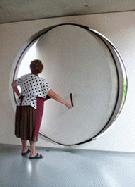
S
SUBSCRIBEU
UNSUBSCRIBE
E
POST AN EVENTN
POST NEWS | ACTIONL
POST LINK?
POST A DOESANYBODY KNOW?
QUESTION
Lecture--Losing Site: Architecture, Memory and Place
From Issue No. 150 | November 04, 2009
Architectural historian and York University visual arts professor Shelley Hornstein uses several case studies to demonstrate different ways imaginary and real representations of buildings and places trigger, create and shape memory. Her presentation is an overview of her forthcoming book of the same title. Hornstein argues that architecture is best remembered by experiencing a place. The buildings of an experienced environment are vividly preserved in memory. Yet when the architecture is no longer present (for example, if we've left the place, or the architecture is demolished), or if a site is only ever experienced second-hand through photos and descriptions, people carry on remembering those locations. How does architecture, as a built material object, become iconic in non-architectural forms? What is the relationship between the built object and the visual and textual body of imagery that enables our imagination to, in effect, "transport" architecture elsewhere? In what ways do ideas or images we remember of certain buildings or places endure in our memory? What is the relationship of a physical place or building to an idea with a site or object as the material match to anchor or trigger the recollection?
Editors Notes: Interesting, wonder how she will deal with the role of preservation of places...







